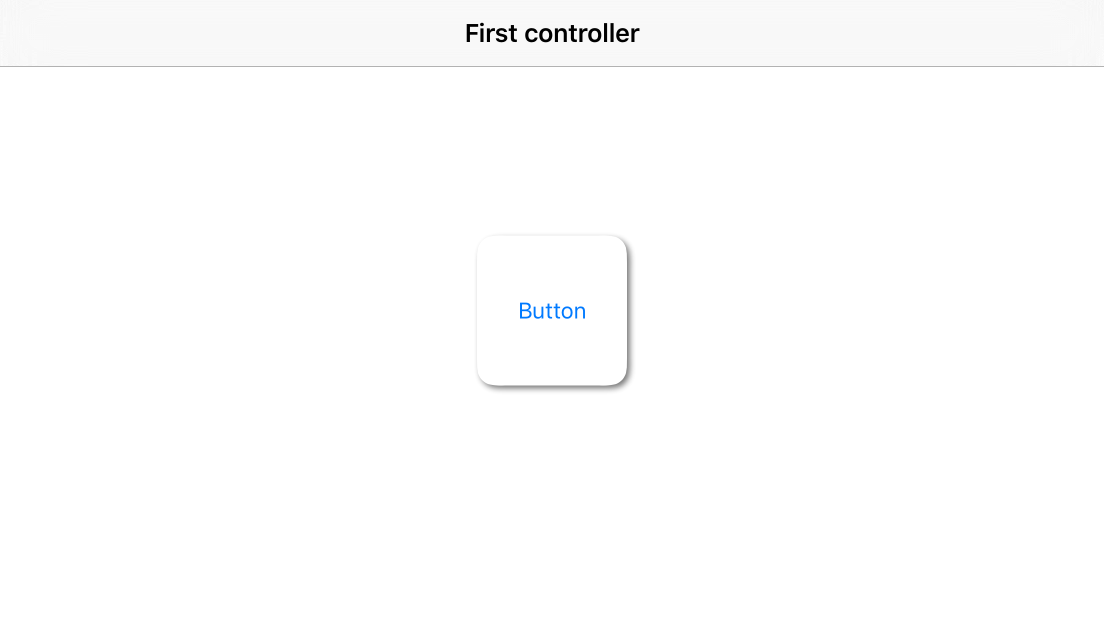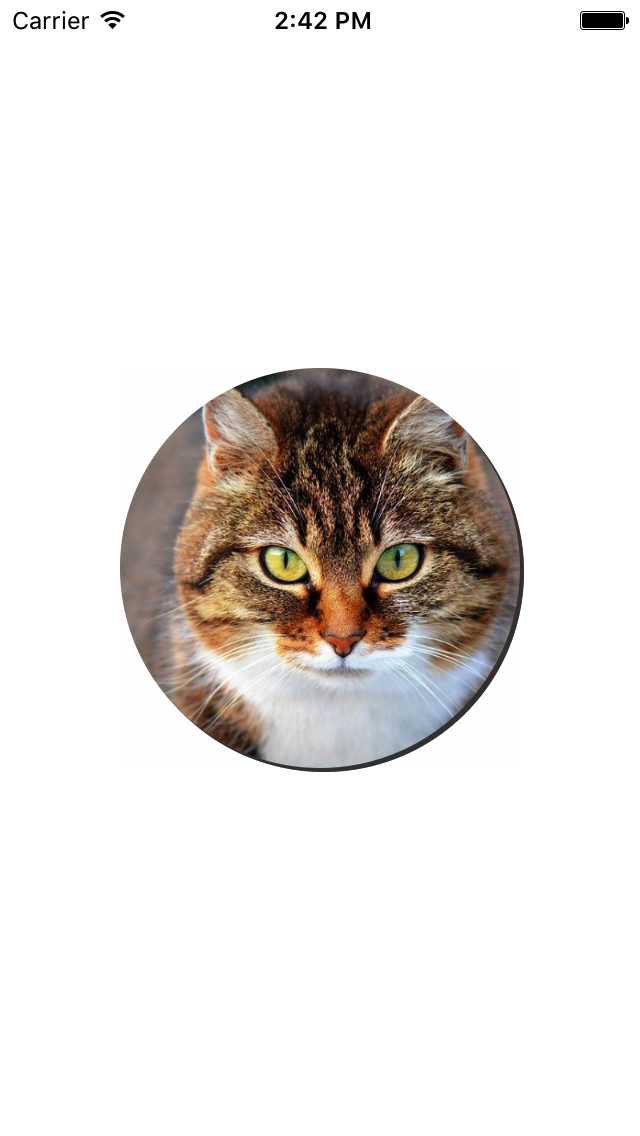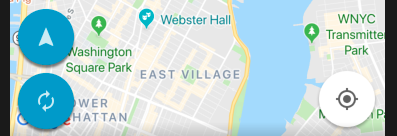Swift-problèmes avec le rayon d'angle et l'ombre portée
J'essaie de créer un bouton avec coins arrondis et une ombre portée . Peu importe comment je passe, le bouton ne s'affichera pas correctement. J'ai essayé masksToBounds = false et masksToBounds = true, mais soit le rayon d'angle fonctionne et l'ombre ne fonctionne pas, soit l'ombre fonctionne et le rayon d'angle ne coupe pas les coins du bouton.
import UIKit
import QuartzCore
@IBDesignable
class Button : UIButton
{
@IBInspectable var masksToBounds: Bool = false {didSet{updateLayerProperties()}}
@IBInspectable var cornerRadius : CGFloat = 0 {didSet{updateLayerProperties()}}
@IBInspectable var borderWidth : CGFloat = 0 {didSet{updateLayerProperties()}}
@IBInspectable var borderColor : UIColor = UIColor.clearColor() {didSet{updateLayerProperties()}}
@IBInspectable var shadowColor : UIColor = UIColor.clearColor() {didSet{updateLayerProperties()}}
@IBInspectable var shadowOpacity: CGFloat = 0 {didSet{updateLayerProperties()}}
@IBInspectable var shadowRadius : CGFloat = 0 {didSet{updateLayerProperties()}}
@IBInspectable var shadowOffset : CGSize = CGSizeMake(0, 0) {didSet{updateLayerProperties()}}
override func drawRect(rect: CGRect)
{
updateLayerProperties()
}
func updateLayerProperties()
{
self.layer.masksToBounds = masksToBounds
self.layer.cornerRadius = cornerRadius
self.layer.borderWidth = borderWidth
self.layer.borderColor = borderColor.CGColor
self.layer.shadowColor = shadowColor.CGColor
self.layer.shadowOpacity = CFloat(shadowOpacity)
self.layer.shadowRadius = shadowRadius
self.layer.shadowOffset = shadowOffset
}
}
8 réponses
Le code Swift 3 suivant montre comment définir une sous-classe de {[2] } qui permet de créer des instances avec des coins arrondis et de l'ombre autour d'elle:
import UIKit
class CustomButton: UIButton {
var shadowLayer: CAShapeLayer!
override func layoutSubviews() {
super.layoutSubviews()
if shadowLayer == nil {
shadowLayer = CAShapeLayer()
shadowLayer.path = UIBezierPath(roundedRect: bounds, cornerRadius: 12).cgPath
shadowLayer.fillColor = UIColor.white.cgColor
shadowLayer.shadowColor = UIColor.darkGray.cgColor
shadowLayer.shadowPath = shadowLayer.path
shadowLayer.shadowOffset = CGSize(width: 2.0, height: 2.0)
shadowLayer.shadowOpacity = 0.8
shadowLayer.shadowRadius = 2
layer.insertSublayer(shadowLayer, at: 0)
//layer.insertSublayer(shadowLayer, below: nil) // also works
}
}
}
Selon vos besoins, vous pouvez ajouter un UIButton dans votre Storyboard et définir sa classe sur CustomButton ou vous pouvez créer une instance de CustomButton par programmation. L'implémentation UIViewController suivante montre comment créer et utiliser une instance CustomButton par programme:
import UIKit
class ViewController: UIViewController {
override func viewDidLoad() {
super.viewDidLoad()
let button = CustomButton(type: .system)
button.setTitle("Button", for: .normal)
view.addSubview(button)
// Auto layout code using anchors (iOS9+)
// set witdh and height constraints if necessary
button.translatesAutoresizingMaskIntoConstraints = false
let horizontalConstraint = button.centerXAnchor.constraint(equalTo: view.centerXAnchor)
let verticalConstraint = button.centerYAnchor.constraint(equalTo: view.centerYAnchor)
let widthConstraint = button.widthAnchor.constraint(equalToConstant: 100)
let heightConstraint = button.heightAnchor.constraint(equalToConstant: 100)
NSLayoutConstraint.activate([horizontalConstraint, verticalConstraint, widthConstraint, heightConstraint])
}
}
Le code précédent produit l'image ci - dessous dans l'iPhone simulateur:
Pour développer le post D'Imanou, il est possible d'ajouter par programme le calque d'ombre dans la classe de boutons personnalisés
@IBDesignable class CustomButton: UIButton {
var shadowAdded: Bool = false
@IBInspectable var cornerRadius: CGFloat = 0 {
didSet {
layer.cornerRadius = cornerRadius
layer.masksToBounds = cornerRadius > 0
}
}
override func drawRect(rect: CGRect) {
super.drawRect(rect)
if shadowAdded { return }
shadowAdded = true
let shadowLayer = UIView(frame: self.frame)
shadowLayer.backgroundColor = UIColor.clearColor()
shadowLayer.layer.shadowColor = UIColor.darkGrayColor().CGColor
shadowLayer.layer.shadowPath = UIBezierPath(roundedRect: bounds, cornerRadius: self.cornerRadius).CGPath
shadowLayer.layer.shadowOffset = CGSize(width: 1.0, height: 1.0)
shadowLayer.layer.shadowOpacity = 0.5
shadowLayer.layer.shadowRadius = 1
shadowLayer.layer.masksToBounds = true
shadowLayer.clipsToBounds = false
self.superview?.addSubview(shadowLayer)
self.superview?.bringSubviewToFront(self)
}
}
Une autre façon d'obtenir un bouton plus utilisable et cohérent.
Swift 2
func getImageWithColor(color: UIColor, size: CGSize, cornerRadius:CGFloat) -> UIImage {
let rect = CGRectMake(0, 0, size.width, size.height)
UIGraphicsBeginImageContextWithOptions(size, false, 1)
UIBezierPath(
roundedRect: rect,
cornerRadius: cornerRadius
).addClip()
color.setFill()
UIRectFill(rect)
let image: UIImage = UIGraphicsGetImageFromCurrentImageContext()
UIGraphicsEndImageContext()
return image
}
let button = UIButton(type: .Custom)
button.frame = CGRectMake(20, 20, 200, 50)
button.setTitle("My Button", forState: UIControlState.Normal)
button.setTitleColor(UIColor.blackColor(), forState: UIControlState.Normal)
self.addSubview(button)
let image = getImageWithColor(UIColor.whiteColor(), size: button.frame.size, cornerRadius: 5)
button.setBackgroundImage(image, forState: UIControlState.Normal)
button.layer.shadowRadius = 5
button.layer.shadowColor = UIColor.blackColor().CGColor
button.layer.shadowOpacity = 0.5
button.layer.shadowOffset = CGSizeMake(0, 1)
button.layer.masksToBounds = false
Swift 3
func getImageWithColor(_ color: UIColor, size: CGSize, cornerRadius:CGFloat) -> UIImage? {
let rect = CGRect(x: 0, y: 0, width: size.width, height: size.height)
UIGraphicsBeginImageContextWithOptions(size, false, 0)
color.setFill()
UIBezierPath(roundedRect: rect, cornerRadius: cornerRadius).addClip()
color.setFill()
UIRectFill(rect)
let image: UIImage = UIGraphicsGetImageFromCurrentImageContext()!
UIGraphicsEndImageContext()
return image
}
let button = UIButton(type: .custom)
button.frame = CGRect(x:20, y:20, width:200, height:50)
button.setTitle("My Button", for: .normal)
button.setTitleColor(UIColor.black, for: .normal)
self.addSubview(button)
if let image = getImageWithColor(UIColor.white, size: button.frame.size, cornerRadius: 5) {
button.setBackgroundImage(image, for: .normal)
}
button.layer.shadowRadius = 5
button.layer.shadowColor = UIColor.black.cgColor
button.layer.shadowOpacity = 0.5
button.layer.shadowOffset = CGSize(width:0, height:1)
button.layer.masksToBounds = false
Pour améliorer la réponse de PiterPan et montrer une ombre réelle (pas seulement un arrière-plan sans flou) avec un bouton circulaire dans Swift 3:
override func viewDidLoad() {
super.viewDidLoad()
myButton.layer.masksToBounds = false
myButton.layer.cornerRadius = myButton.frame.height/2
myButton.clipsToBounds = true
}
override func viewDidLayoutSubviews() {
addShadowForRoundedButton(view: self.view, button: myButton, opacity: 0.5)
}
func addShadowForRoundedButton(view: UIView, button: UIButton, opacity: Float = 1) {
let shadowView = UIView()
shadowView.backgroundColor = UIColor.black
shadowView.layer.opacity = opacity
shadowView.layer.shadowRadius = 5
shadowView.layer.shadowOpacity = 0.35
shadowView.layer.shadowOffset = CGSize(width: 0, height: 0)
shadowView.layer.cornerRadius = button.bounds.size.width / 2
shadowView.frame = CGRect(origin: CGPoint(x: button.frame.origin.x, y: button.frame.origin.y), size: CGSize(width: button.bounds.width, height: button.bounds.height))
self.view.addSubview(shadowView)
view.bringSubview(toFront: button)
}
Si quelqu'un a besoin d'ajouter des ombres à arrondi boutons Swift 3.0, voici une bonne méthode pour le faire.
func addShadowForRoundedButton(view: UIView, button: UIButton, shadowColor: UIColor, shadowOffset: CGSize, opacity: Float = 1) {
let shadowView = UIView()
shadowView.backgroundColor = shadowColor
shadowView.layer.opacity = opacity
shadowView.layer.cornerRadius = button.bounds.size.width / 2
shadowView.frame = CGRect(origin: CGPoint(x: button.frame.origin.x + shadowOffset.width, y: button.frame.origin.y + shadowOffset.height), size: CGSize(width: button.bouds.width, height: button.bounds.height))
self.view.addSubview(shadowView)
view.bringSubview(toFront: button)
}
Utiliser cette méthode dans func viewDidLayoutSubviews() comme ci-dessous:
override func viewDidLayoutSubviews() {
addShadowForRoundedButton(view: self.view, button: button, shadowColor: .black, shadowOffset: CGSize(width: 2, height: 2), opacity: 0.5)
}
Refactorisé CE pour supporter n'importe quelle vue. Sous-classe votre vue à partir de cela et il devrait avoir des coins arrondis. Si vous ajoutez quelque chose comme un UIVisualEffectView en tant que sous-vue à cette vue, vous devrez probablement utiliser les mêmes coins arrondis sur ce UIVisualEffectView ou il n'aura pas de coins arrondis.
/// Inspiration: https://stackoverflow.com/a/25475536/129202
class ViewWithRoundedcornersAndShadow: UIView {
private var theShadowLayer: CAShapeLayer?
override func layoutSubviews() {
super.layoutSubviews()
if self.theShadowLayer == nil {
let rounding = CGFloat.init(22.0)
let shadowLayer = CAShapeLayer.init()
self.theShadowLayer = shadowLayer
shadowLayer.path = UIBezierPath.init(roundedRect: bounds, cornerRadius: rounding).cgPath
shadowLayer.fillColor = UIColor.clear.cgColor
shadowLayer.shadowPath = shadowLayer.path
shadowLayer.shadowColor = UIColor.black.cgColor
shadowLayer.shadowRadius = CGFloat.init(3.0)
shadowLayer.shadowOpacity = Float.init(0.2)
shadowLayer.shadowOffset = CGSize.init(width: 0.0, height: 4.0)
self.layer.insertSublayer(shadowLayer, at: 0)
}
}
}
My custom bouton certains ombre et coins arrondis, je l'utilise directement dans le Storyboard, sans avoir besoin de touch programme.
Swift 4
class RoundedButtonWithShadow: UIButton {
override func awakeFromNib() {
super.awakeFromNib()
self.layer.masksToBounds = false
self.layer.cornerRadius = self.frame.height/2
self.layer.shadowColor = UIColor.black.cgColor
self.layer.shadowPath = UIBezierPath(roundedRect: self.bounds, cornerRadius: self.layer.cornerRadius).cgPath
self.layer.shadowOffset = CGSize(width: 0.0, height: 3.0)
self.layer.shadowOpacity = 0.5
self.layer.shadowRadius = 1.0
}
}
Ajoutez simplement le code suivant pour le rayon de coin et l'ombre, vous devez donner de la couleur d'arrière-plan à la vue, de sorte que l'ombre n'affecte pas les sous-vues.
func shadowOnviewWithcornerRadius(YourView:UIView)
{
YourView.layer.shadowColor = UIColor.black.cgColor;
YourView.layer.shadowOpacity = 0.5;
YourView.layer.shadowRadius = 5;
YourView.layer.shadowOffset = CGSize(width :0, height :0)
YourView.layer.masksToBounds = false;
YourView.layer.cornerRadius = 2.0;
YourView.layer.borderWidth = 0.5;
YourView.backgroundColor = UIColor.white;
}



